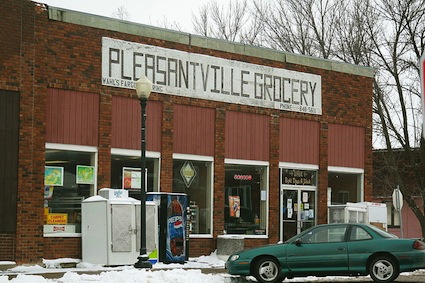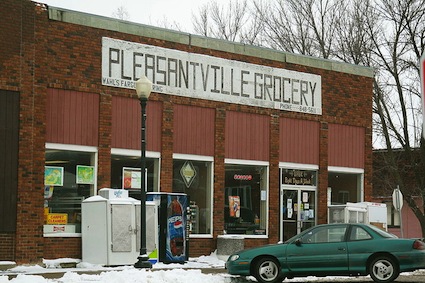 A locally owned grocery in Pleasantville, Iowa. Photo: Ashton B Crew, wikimedia commonsA few weeks ago, when the Obama administration released its Food Desert Locator, many of us realized that a once-good idea has spoiled like a bag of old bread. If you go online and find that your family lives in a food desert, don’t worry: You have plenty of company. One of every 10 census tracts in the lower 48 has been awarded that status.
A locally owned grocery in Pleasantville, Iowa. Photo: Ashton B Crew, wikimedia commonsA few weeks ago, when the Obama administration released its Food Desert Locator, many of us realized that a once-good idea has spoiled like a bag of old bread. If you go online and find that your family lives in a food desert, don’t worry: You have plenty of company. One of every 10 census tracts in the lower 48 has been awarded that status.
Two years ago, when one of us (Gary) moved to the village of Patagonia, Ariz., he inadvertently chose to reside in what the USDA deems to be the edge of a food desert. Its maps show that Gary now lives more than 15 miles away from a full-service supermarket or chain grocery store that has 50 or more employees and grosses $2 million or more in food sales each year. Apparently, that’s bad. Gary and his low-income neighbors are now being told that if they were bright enough to reside within walking distance or five minutes driving distance of a Safeway, Alberston’s, Winn-Dixie, or Walmart, they would undoubtedly be more “food secure.”
Why? A USDA report [PDF] to Congress in 2009 suggested that the average food in such big-box grocery stores is priced 10 percent lower than its counterparts in independently owned corner stores, roadside stands, or farmers markets. What’s more, the USDA claimed that “full service” big-box stores offer more affordable access to food diversity than do other venues.
Those assertions may be the biggest bunch of road apples that the USDA has ever tried to force down the throats of low-income Americans. The fatal flaw of the Obama strategy to reduce hunger, food insecurity, and obesity in America is that it risks bringing more big-box stores both to poor urban neighborhoods and to rural communities. It categorically ignores the fact that independently owned groceries, corner markets in ethnic neighborhoods, farmers markets, CSAs, and roadside stands are the real sources of affordable food diversity in America. But in its 2009 report to Congress, the USDA conceded that “a complete assessment of these diverse food environments would be such an enormous task” that it decided not to survey independently owned food purveyors. Therefore, it decided to ignore their beneficial roles and focus on the grocery-store chains that now capture three-quarters of all current foods sales in the U.S.
Unfortunately, we will get what we measure. The $400 million that the Obama administration has set aside to create greater food access in these so-called food deserts will likely go to attracting full-service grocery franchises that heap upon our children megatons of empty calories like those in high-fructose corn syrup and corn oil — yes, the very products that emerge from Secretary of Agriculture Tom Vilsack’s own great state of Iowa. But the profits made in those big-box stores will drain away from our neighborhoods and communities, bound for distant corporate headquarters, further impoverishing most food producers and consumers.
Instead, what we need is tangible support for rebuilding the rural and urban infrastructure that can enable more marketing of fresh, local foods by farmers, orchard keepers, and ranchers directly to neighboring consumers. The lack of a big-box store in our community may be an asset, not a disadvantage in keeping our children healthy and food secure. In Patagonia, we have a family-owned grocery, Red Mountain Foods, that uses its 900 square feet of indoor space and seasonal roadside displays to provide our 800 residents with a great diversity of nutritious whole foods, including both local and organic options.
Food stamp or “SNAP” purchases made by low-income residents currently account for more than 5 percent of Red Mountain’s $300,000 average annual food sales, and have allowed a doubling of local access to healthy foods in the last couple years. Red Mountain also provides $3,000 of healthy snacks annually to the Patagonia Schools, which have a high percentage of children from low-income families in its classes. In addition to Red Mountain Foods, Patagonians have access to two summer farmers markets within a 10-mile radius, a year-round community garden, and direct sales of grass-fed meat and apples from local ranches and orchards.
Ironically, the USDA’s Food Environment Atlas already offers a far more complete picture of food access on a county-by-county basis than does the new Food Desert Locator. Borderland communities like ours may still suffer from undeniable poverty, but if supported, not obstructed, their informal and local food economies may keep them from becoming true food “dead zones” where locally produced nutrients fail to reach those who need them the most. Nevertheless, we do indeed need help in rebuilding meat processing plants, grain mills, and community kitchens to make the best use of our locally produced beef, mesquite, fruits, and chiles. What we emphatically do not need is a Safeway or Walmart in our midst.
As a result of the chronic lack of USDA co-investment with rural communities in food security–enhancing local infrastructure, this country now has fewer farmers than it does Department of Agriculture employees. It is a sad sign of the times when a misguided bureaucracy has grown to a size larger than the constituency it was originally charged to help: the farmers and ranchers of America. If there are to be cuts to the USDA budget, let it be to the bureaucracy itself and not to the sustainable agriculture and economic development grants that go directly to farmers, ranchers, and small-scale growers in urban community gardens.
Finally, let’s junk the term “food deserts” forever, and change government policies that have inexorably fostered food dead zones in both rural and urban areas. It’s time we quit intensifying the inequities in the globalized food economy and start investing in a food future that creates true food justice by wedding relocalization with fair trade between regions.



